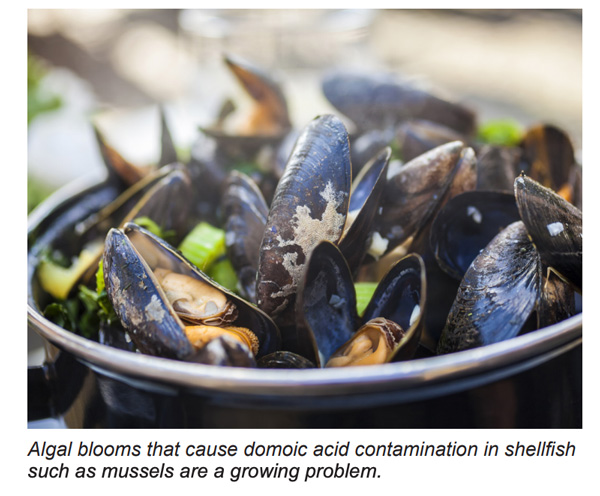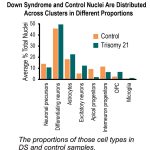Home / Stories /
 by Catherine Arnold
by Catherine Arnold
September 3, 2020
Alfred Hitchcock may have taken inspiration for his film The Birds from an episode of shellfish poisoning. To back up a bit, after hundreds of seabirds slammed into houses, cars, and people in a California town near where Hitchcock had a summer residence, it’s believed his Tippi Hedren classic idea took root. Research showed the birds likely were poisoned by eating contaminated sea life.
Those birds may have been exhibiting symptoms of a potentially deadly illness that can result when avian life, marine mammals or humans consume shellfish — or other seafood, such as sardines and anchovies — that are contaminated with the neurotoxin called domoic acid (DA). That substance is primarily produced by a marine algal species called Pseudonitzschia; shellfish and fish with fins are exposed when filter feeding on algae in ocean waters. According to the National Oceanic and Atmospheric Agency (NOAA), the algal blooms that produce DA are a growing problem in coastal and inland waters. In 1987, over 150 people were poisoned and four people died after eating contaminated mussels harvested off Prince Edward Island, Canada. Since then, authorities in countries including the United States, Canada, the European Union, New Zealand, and Australia enforced a safety limit of 20 parts per million in shellfish on their coasts. Based on those standards, marine authorities monitor commercial fishing and issue warnings to the public; there have been no major outbreaks of DA poisoning in humans since the regulation began. However, mass die-offs in wildlife populations such as the California sea lion have been attributed to DA poisoning.
Do Current Regulations Adequately Protect Vulnerable Populations?
Although environmental regulations are in place to protect humans from high-level DA poisoning, long-term exposure to low levels of DA is becoming more frequent. Scientific investigations are now focusing on whether someone who regularly eats shellfish and other seafood contaminated with low levels of DA is at risk of adverse health effects and neurological dysfunction. “The scientific question researchers have asked is ‘Are we protecting vulnerable populations if we just keep people from eating domoic acid if it reaches 20 parts per million?’” says Thomas M. Burbacher, PhD, a professor in Environmental and Occupational Health Sciences and head of CHDD’s Developmental Toxicology Research Emphasis Area and Animal Behavior Core. “What about repeated, even daily, consumption during pregnancy? Could we see more subtle effects on how the developing brain functions?’” Since 2015, Burbacher and other CHDD research affiliates have been studying domoic acid exposure using a nonhuman primate model to learn whether low-level exposure during pregnancy affects infant development. In order to imitate the experiences of human females in coastal communities eating a steady diet of seafood, researchers exposed primates to daily oral doses of DA before, during, and after pregnancy. They used DA doses that bracket the current regulatory limit for humans.
Some of the results were unexpected. While researchers anticipated finding differences in infants, they did not bank on the noticeable changes they found in exposed primate mothers. Having observed subtle tremors in some exposed animals while reaching for an apple slice in biweekly clinical exams, they later did MRIs and whole-brain scans using Diffusion Tensor Imaging (DTI), a method for characterizing microstructural changes in the brain or differences resulting from neuropathology and treatment. DTI analysis revealed that DA exposed females that exhibited tremors had changes in fractional anisotropy, a measure of structural integrity that occurred in brain areas including the internal capsule, fornix, pons, and corpus callosum. These findings are the first documented results suggesting that chronic oral exposure to DA at concentrations near the current human regulatory limit “are related to structural and chemical changes in the adult primate brain,” according to their May 2020 publication in Neurotoxicology, one of several published papers resulting from the project. DA exposed infants were also affected, demonstrating poor visual memory for faces and abstract patterns.
Research Informs
Policy Data from Burbacher’s programs are used to help formulate policies that protect humans from chemical exposure. In 2007, he was a co-author on a World Health Organization (WHO) publication on principles for evaluating health risks in children associated with exposure to chemicals. After conducting methylmercury research, he was a member of a National  Academy of Science committee that reviewed new mercury standards proposed by EPA to protect children’s health and published the report “Toxicological Effects of Methylmercury.” Recently he has been in touch with a food contamination and toxicology evaluator with the Canadian government to discuss the DA study and results.
Academy of Science committee that reviewed new mercury standards proposed by EPA to protect children’s health and published the report “Toxicological Effects of Methylmercury.” Recently he has been in touch with a food contamination and toxicology evaluator with the Canadian government to discuss the DA study and results.
Finding and stopping chemical risks to the human brain has driven Burbacher’s work from his college years, when he heard a speaker in an undergraduate psychology class talk about studying how chemical exposures change how brains function. “I started working in that person’s lab soon after,” he says. “And have been doing that work for the last 40 years.” It’s vital work, Burbacher says. “We don’t want to allow exposures that will damage the developing brain. If you look at policy, more and more, we’re talking about protecting children. We’re doing it now, but it’s been a long time coming. It’s important that our public health policies protect vulnerable populations, especially children.”


